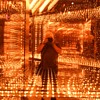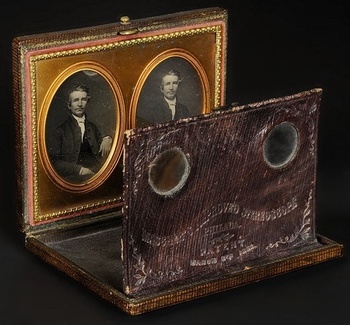Posted 9 years ago
 rniederman
rniederman
(350 items)
Long before radio, television and social media (etc.), photography was an early form of entertainment. Stereo photography, in particular, was very exciting. Stereo daguerreotypes and a way to view them started appearing in 1841; however, the first truly portable viewers became available in 1853.
John Mascher, a Philadelphia inventor, patented a novel approach by adding a hinged viewing flap with a pair of magnifying lenses to an ordinary daguerreotype case. These early “Mascher” style viewing cases became quite popular for a brief period from 1853 to 1856.
Shown here is a very nice example of an early Mascher viewing case with its original pair of ninth plate stereo daguerreotypes of a gentleman. When closed, the viewer looks like any typical leather covered, quarter plate, push-button image case. Opening the case reveals the patented leather viewing flap imprinted with “Mascher’s Improved Stereoscope” and its patent information of March 8th, 1852 ... the first American patent for a stereoscopic viewing device (#9611). Oddly, the viewer’s imprint is the year 1852 but the actual patent is dated as 1853.
Viewing the image is somewhat cumbersome. You have to somehow grasp the case while at the same time hold upright the viewing flap and image. Although clumsy, the stereo 3D effect for this particular image is quite good.















































Amazing pix actually ... just slightly different but when you look at them in pic. 2 they are quite distinctly different .... in tone as well as in perspective ... does that make sense ????
A Gorgeous Device !!!
FANTASTIC!!!! VERY NICE ROB!!
You have a nice collection of these-- hard to find!
scott
Thanks, Kevin and Sean. Kevin ... you have a good eye. The pose is identical but you are seeing a slightly different perspective. This is from using a stereo camera with lenses separated by about the same distance as your eyes (referred to as interocular spacing). Underneath the frame are two separate daguerreotypes. While the two images were taken at the same time, each plate had to be developed separately which accounts for the slight difference in tonality. You can see another example of the same concept by looking at my Stull viewer post at: http://www.collectorsweekly.com/stories/169537-stull-daguerreotype-viewing-case-c-1855?in=user
Thanks, Scott ... I'm slowly building a collection of early stereo dags in their viewers to go along with my cameras.
Your very welcome Rob!!
Thanks!
Michael
BB2
fortapache
Very interesting!
Thanks!
shughs
Longings
racer4four
Thanks!
mtg75
aura
Caperkid
As I lack a stereo viewer of any kind, it's nice that I can see the effect via the cross-eyed method. Wonderful image!
Rob, another top shelf posting, really neat image viewer, I've never seen one this early, Thanks for sharing and the history.
Thanks!
Designer
kyratango
sanhardin
Thanks!
AnnaB
sugargirl
gargoylecollector
Thanks!
Roycroftbooksfromme1
egreeley1976
Manikin
Thanks!
David
Lady_Picker
SpiritBear
Thanks!
John
Ben
Thanks!
Radegunder
f64imager
leighannrn
This is a fine example!
Thanks!
Hunter
Moonstone
Kerry
Thanks!
Tanni
verbatim
crazycharacter
crswerner
Thanks!
Bluereded
AntigueToys
Nicefice
Thanks!
snowman3
Beachbum58
Thanks, MooreAntique!
Thanks, chrissylovescats!
Good day Russ, what is your opinion on the "A" series Canon SLR cameras, I recently acquired at least on of each and a few doubles of a couple. Only one I didn't get, was the A T. 10 cameras total and various lenses.......everything was very well cared for and minty. The A-1 is nos in box,
Anyways, my question is what ISO film should I use to get acquainted with camera and technic s
Hi Kerry. The Canon A Series was an important camera because it was the first to incorporate nearly all of the key automated exposure modes seen in today's cameras. The A Series was well built and very popular. The AT is the manual version of the cameras.
As far as film ... ISO 100 - 200 print film is a decent place to start because the colors are decent and exposure latitude (variations from good exposures) is foregiving. Sharpness is pretty good. Keep in mind that the higher the ISO (such as 400 for dimmer settings without flash), the grainier the image.
If you're after the richest colors and finest grain for outdoor shooting, go with lower ISO (i.e. 100) transparency film.
FWIW ... at end of my roll film shooting days (35mm through 6x7 cm), I was shooting a lot of Fujichrome.
Have fun. - Rob
Thanks Russ, I will have to experiment with some 200 Fuji, it's available at my local Walmart and 4 rolls of 24 is 9 bucks, fun place to start. I acquired all the cameras and 14 different lens for 85 bucks, so will have to give it a shot.....Thanks again
Kerry ... I'll be interested to hear about your results. - Rob
Thanks, pops52!
Thanks, Oroyoroyisthatyourhorse!
How impressive!
Thanks, PCC!